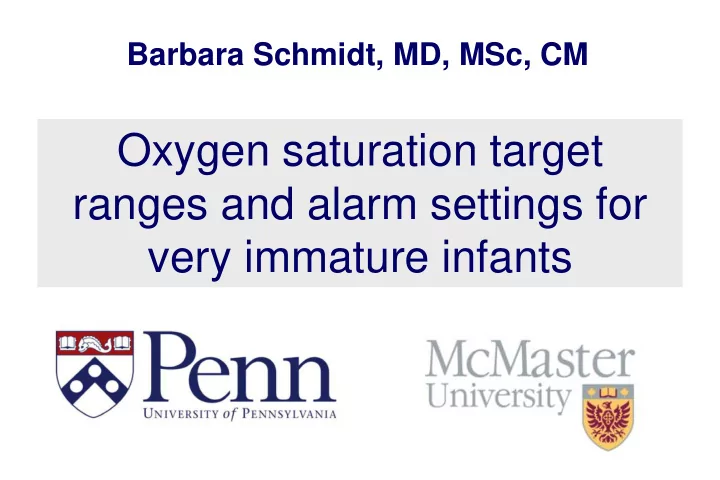

Barbara Schmidt, MD, MSc, CM Oxygen saturation target ranges and alarm settings for very immature infants
Outline • Design and main results of the Canadian Oxygen Trial (COT) • IPD Meta-analysis of COT, SUPPORT and the 3 BOOST trials • Saturation target ranges vs alarms • Which target ranges and alarms are right for your patients?
Barbara Schmidt, Robin Whyte, Elizabeth Asztalos, Diane Moddemann, Christian Poets, Yacov Rabi, Alfonso Solimano, Robin Roberts and The COT Investigators
Main COT Study Question P In infants born at 23 0/7 to 27 6/7 wk, I does a target saturation of 85-89% C compared with 91-95% O increase or decrease the risk of death or neurosensory disability at a corrected age of 18 months? T
Target range for displayed saturations on off-set pulse oximeters: 88-92% Low target range for true saturations: 85-89% High target range for true saturations: 91-95%
Death or Disability at 18 Months 85-89% 91-95% 283 of 569 298 of 578 49.7% 51.6% OR = 1.08 95% CI 0.85-1.37 p = .52
Components of Primary Outcome 85-89% 91-95% OR (95%CI) Death 16.6% 15.3% 1.1 (0.8-1.5) GMFCS ≥2 6.1% 6.4% 1.0 (0.6-1.7) Bayley III < 85 40% 40% 1.0 (0.8-1.3) Deafness 3.7% 2.5% 1.5 (0.7-3.2) Blindness 1.0% 0.6% 1.7 (0.4-7.1)
Secondary Outcomes 85-89% 91-95% P-value Severe 12.8% 13.1% .80 ROP NEC 12.3% 9.3% .10 Targeting lower saturations reduced the PMA at last use of oxygen therapy by 0.8 weeks; 95% CI -1.5 to -0.1; P=.03
COT Conclusions Targeting oxygen saturations of 85-89% as compared with 91-95% had no significant effect on rates of • death or disability at 18 months • death before 18 months • necrotizing enterocolitis • severe retinopathy of prematurity
Outline • Design and main results of the Canadian Oxygen Trial (COT) • Meta-analysis of COT, SUPPORT and the 3 BOOST trials • Saturation target ranges vs alarms • Which target ranges and alarms are right for your patients?
Effects of Targeting Lower Saturations Death before Severe ROP Trial Follow-up ↓↓ SUPPORT BOOST NZ No Diff No Diff BOOST AU No Diff No Diff BOOST UK No Diff No Diff COT No Diff No Diff
JAMA 2018; 319:2190-2201
Main NeOProM Results SpO 2 SpO 2 Adjusted RR P- Risk 85-89% 91-95% (95%CI) value Difference Primary 53.5% 51.6% 1.04 (0.98, 1.09) 0.21 outcome Major disability 40.5% 40.5% 1.00 (0.93, 1.08) 0.97 Death 19.9% 17.1% 1.17 (1.04, 1.31) 0.01 2.8% Severe NEC 9.2% 6.9% 1.33 (1.10, 1.61) 0.003 2.3% ROP treatment 10.9% 14.9% 0.74 (0.63, 0.86) <0.001 4.0% This IPD meta-analysis is an important achievement but has delivered no surprises!
AAP Conclusion Recent RCTs suggest that a targeted oxygen saturation range of 90% to 95% may be safer than 85% to 89%, at least for some infants. However, the ideal oxygen saturation range for extremely low birth weight infants remains unknown.
Survey conducted Nov 2015 to Feb 2016 “We detected 40 different SpO2 ranges, and even the most frequently reported range (i.e., 90 – 95%) was used in only 28% of the 193 respondent NICUs.”
NeOProM Intervention Compliance Alarm settings? with alarm settings? Duration of targeting? Response to alarms? Impact of reversal from off-set to true Transfusion policies? saturations?
Outline • Design and main results of the Canadian Oxygen Trial (COT) • Meta-analysis of COT, SUPPORT and the 3 BOOST trials • Saturation target ranges vs alarms • Which target ranges and alarms are right for your patients?
Target ranges are not alarm settings
Protocol-prescribed alarm settings after conversion to true SpO 2
Goal of Oxygen SaturationTargeting “ Providers need to understand that cumulative oxygen saturations over time represent a bell shaped curve, and the role of the health care team is to minimize the tails in both directions ”. Greenspan and Goldsmith, Pediatrics 2006; 118:1741
Intermittent Hypoxemia and Late Death or Disability JAMA 2015;314:595-603
Intermittent Hypoxemia and Motor Impairment JAMA 2015;314:595-603
AAP Conclusion Alarm limits are used to avoid potentially harmful extremes of hyperoxemia or hypoxemia. Given the limitations of pulse oximetry and the uncertainty that remains regarding the ideal oxygen saturation target range for infants of extremely low birth weight, these alarm limits could be fairly wide.
AAP Conclusion Regardless of the chosen target, an upper alarm limit approximately 95% while the infant remains on supplemental oxygen is reasonable.
AAP Conclusion A lower alarm limit will generally need to extend somewhat below the lower target, as it must take into account practical and clinical considerations, as well as the steepness of the oxygen saturation curve at lower saturations.
Outline • Design and main results of the Canadian Oxygen Trial (COT) • Meta-analysis of COT, SUPPORT and the 3 BOOST trials • Saturation target ranges vs alarms • Which target ranges and alarms are right for your patients?
Outcome Rates Differ Between Trials Death before Severe ROP Trial Follow up SUPPORT 20.1% 13.4% BOOST NZ 15.3% 7.5% BOOST AU 16.7% 7.7% BOOST UK 22.8% 19.2% COT 15.9% 12.9%
NeOProM Number needed to treat (NNT) or harm (NNH) with higher saturation target range: Outcome NNT NNH Mortality 36 Severe NEC 44 Treated ROP 25
Absolute effects of higher targeting will depend on our patients’ baseline risks Example: Mortality Baseline Absolute Risk NN Risk Reduction Treat 20% 2.8% 36 10% 1.4% 71 5% 0.7% 143
An example from a Canadian NICU Outcome Rate NNT NNH Mortality 9% 77 Surgical NEC 4% 100 Severe ROP 13% 21 Our oximeter alarms have been set at 85% and 95% for many years. Why should we change them?
Recommend
More recommend